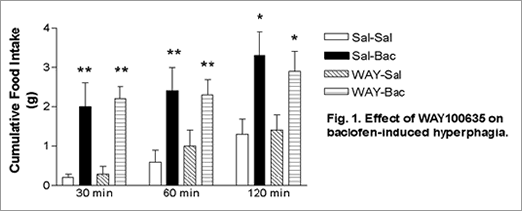102P Brighton
Winter Meeting December 2007 |
Effects of the 5-HT1A receptor antagonist WAY100635 on Baclofen-induced hyperphagia in non-deprived rats
Sunit Patel, Ivor Ebenezer. University of Portsmouth, Portsmouth, United Kingdom.
Sunit Patel, Ivor Ebenezer. University of Portsmouth, Portsmouth, United Kingdom.
Both central and systemic administration of the GABAB receptor agonist baclofen increases food consumption in non-deprived rats by a central GABAB receptor mediated mechanism (Ebenezer et al., 1994). However, little is known about the mechanism(s) by which baclofen increases feeding. Wirtshafter et al. (1993) have demonstrated that micro-injection of baclofen into the median raphe nucleus produces hyperphagia in rats, It is well known that stimulation of 5-HT1A somatodendritic auto-receptors in the raphe nucleus increases food intake in experimental animals (see Ebenezer et al., 2007).In order to test the possibility that baclofen acts to increase levels of 5-HT in the raphe nucleus which, in turn, stimulates 5-HT1A auto-receptors to produce hyperphagia, we investigated the effects of baclofen on food intake in rats pre-treated with the 5-HT1A receptor antagonist WAY100635 (N-[2-(4-2-methoxyphenyl)-1-piperazinyl]-N-(2-pyridyl) cyclohexanecarboxamide).
Male Wistar rats (n=7; b. wt. 310 – 350g) were housed in groups of 4 and had free access to food and water at all times. During experimental trials, the rats were injected i.p. with either saline (sal) followed 15 min later by sal., sal followed by baclofen (bac; 2 mg kg-1), WAY100635 (WAY; 0.6 mg kg-1) followed by sal, or WAY (0.6 mg kg-1) followed by bac (2 mg kg-1). Immediately after the 2nd injection the rats were placed singly in separate experimental cages with free access to food and water for 120 min. and cumulative food intake was measured at intervals. A repeated measures design was used with each rat receiving all treatments; 4 days separated successive drug trials. The data was analysed by ANOVA and Newman-Keuls post-hoc test. Bac significantly increased cumulative food intake at each of the measurement intervals (Fig. 1). WAY had no effect on cumulative food intake on its own and did not reverse the hyperphagic effect of baclofen. The dose of WAY used was on the higher end of doses that have been demonstrated to abolish the hyperphagia produced by 5-HT1A receptor agonists (Ebenezer et al., 2007). The results of this study show that pre-treatment with WAY does not attenuate the hyperphagia induced by baclofen in non-deprived rats and indicates that the effect of baclofen on feeding is not secondary to an action of 5-HT on 5-HT1A auto-receptors in the raphe nucleus.

Ebenezer, I.S. et al. (2007) Meths. Find. Expt. Clin. Pharmacol, 29, 269 – 272
Ebenezer, I.S. et al. (1994) Meths. Find. Expt. Clin. Pharmacol., 26, 627 – 630.
Wirtshafter, D. et al. (1993) Behav. Brain Res., 59, 83 – 93.
|